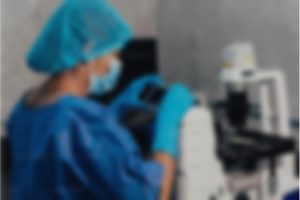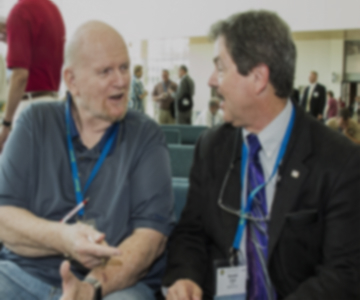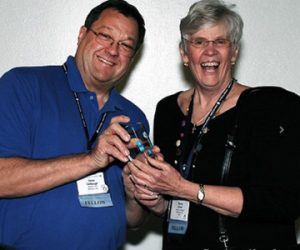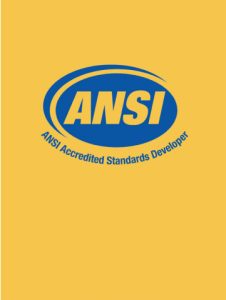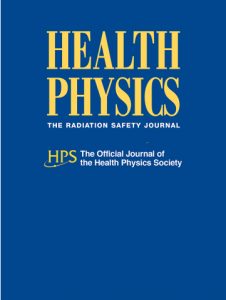1918 — 2008
by Joyce Landsverk


♦♦♦
To view the HPS History Committee interview with Don Collins, click here.
♦♦♦
Donald Leslie Collins, son of Leslie George Collins and Gladys Geneva Harrison Collins, was born in Detroit, Michigan, on 5 August 1918. He grew up in the small town of Avoca, Michigan, where his dad owned and operated the grain elevator. He attended Yale High School, Port Huron Junior College, and Michigan State University. In 1942 he married Helen Grace Watson, also of Avoca, Michigan. She preceded him in death in 1986.
Don served in the U.S. Army during World War II and worked on the Manhattan Project. He worked for Victoreen Instrument Company in Cleveland, Ohio. Later he worked as vice president at Landsverk Electrometer Company in Glendale, California. After that he formed the company Don L. Collins & Associates. He was active in the Health Physics Society and the International Radiation Protection Association.
Don enjoyed flying Cessna airplanes and was a member of Sky Roamers. He enjoyed learning new ideas, reading, and traveling around the world. Don also loved exploring the beauty of nature, camping, and meeting new people. He belonged to several local art associations and several local square dance groups. He was an active member of the North Glendale and First United Methodist Church since 1955. He also had an avid interest in genealogy.
Don is survived and loved by his five daughters: Joyce and David Landsverk of Mar Vista, California; Janice and Kenneth Baird of Post Falls, Idaho; Barbara and Steve Heppe of Mesa, Arizona; Donna and Charles Everhart of Santa Clarita, California; and Susan Collins of Philadelphia, Pennsylvania. He is also survived by 10 grandchildren; five great-grandchildren; one brother, Russ and June Collins of Port Huron, Michigan; one sister, Marian and Ralph Vesper of Yale, Michigan; and many nieces and nephews. He was preceded in death by two sisters, Aletha Emo and Marjorie Foust.
by Donna L. Earley
On Saturday, 23 February 2008, the Health Physics Society lost a longtime member, photographer, and storyteller. Don L. Collins passed away in Glendale, California, after a long career that spanned over 60 years of health physics. Don was among the very first group of professionals to call themselves health physicists. He always considered it his good fortune to become a physicist during the time that the world's best scientists were all engaged together in the war effort and a young inexperienced physicist could sit side by side with Nobel scientists. As a young physicist, I was captivated by his entertaining stories about the Manhattan Project and people such as Arthur Compton, Enrico Fermi, Ernest Lawrence, and General Leslie R. Groves. He detailed many of his adventures in Ron Kathren's and Paul Ziemer's book Health Physics: A Backward Glance (Pergamon Press 1980).
Don began his education in a one-room schoolhouse in Michigan. He earned an EE degree from the Detroit Radio Electronics Television School in 1939 and a BS in physics from Michigan State in 1942. Upon graduation, Don joined the Army Air Forces and was assigned to the Manhattan Engineer District. One of his favorite stories was about arriving in New York without any idea where the Manhattan District office was located. He overheard someone talking in a restaurant about working in the "District," followed the gentleman home, showed up the next morning and tailed him to the secret office location. That was the first, but not the last, time he would trigger an investigation by the Security Department during the war.
General Groves transferred Don to the Metallurgical Lab at the University of Chicago, where he was assigned to develop a table of biological effects of radiation for field commanders to use in the event of a nuclear explosion, with Arthur Compton as his tutor in radiation safety. General Arthur V. Peterson soon assigned him to become familiar with any instruments that would be useful for radiation safety, military, and civil defense use.
In 1945 Don became chief of the Instrument Branch, Research Division, and set up civil defense programs in Washington, New York, Chicago, Berkeley, Los Angeles, and London. The program would eventually become the Civil Defense Network. He traveled on special assignment to London to brief General Dwight Eisenhower about some aspects of the Manhattan Project. He was sent home just two days before D-Day, after a buzz bomb destroyed a lab in which his instruments were stored.
He worked with Jack Victoreen and others on developing some of the portable Geiger counters and was just transferred to Oak Ridge when the atomic bombs were dropped in Japan. Don, along with his emergency instruments, was sent to Nagasaki and Hiroshima as part of the Atomic Bomb Investigation Committee to try to estimate radiation exposure doses to the survivors. He later accompanied the team to the Bikini Island tests. His experience convinced him of the need for more accurate radiation-exposure instruments.
After the war, Don spent eight years at Victoreen Instrument Company as its technical director and then joined Landsverk Electrometer Company, where he continued as vice president and then president for 16 years. In 1968 he established his firm, Don L. Collins & Associates, in California. Don joined the Southern California Chapter of the Health Physics Society in 1968 and began a 30-year hobby of photography for both the local and national Society.
Ole Landsverk's son, Dave, married Don's daughter, Joyce, cementing their long family friendship. After retirement Don spent his time immersed in art, genealogy, square dancing, and his family.
Don's tales of his travels, adventures, and experience were always entertaining and his knowledge of instrumentation and calibration were unparalleled. He had a healthy respect for radiation safety practices but little patience for some of the regulatory controls over the use of radiation that developed after the war. When his calibration operation was transferred to Medical X-Ray Enterprises and I became the radiation safety officer for the operations, I gained a greater insight into the more creative interpretations of the new regulations that some of the early licensees took. His interactions with the state regulators mimicked some of the rule-bending adventures he experienced in the war, but he always did so with a smile and a story.
Don was certainly an example of what Tom Brokaw calls the Greatest Generation. His stories, humor, humility, and kindness will surely be missed.

